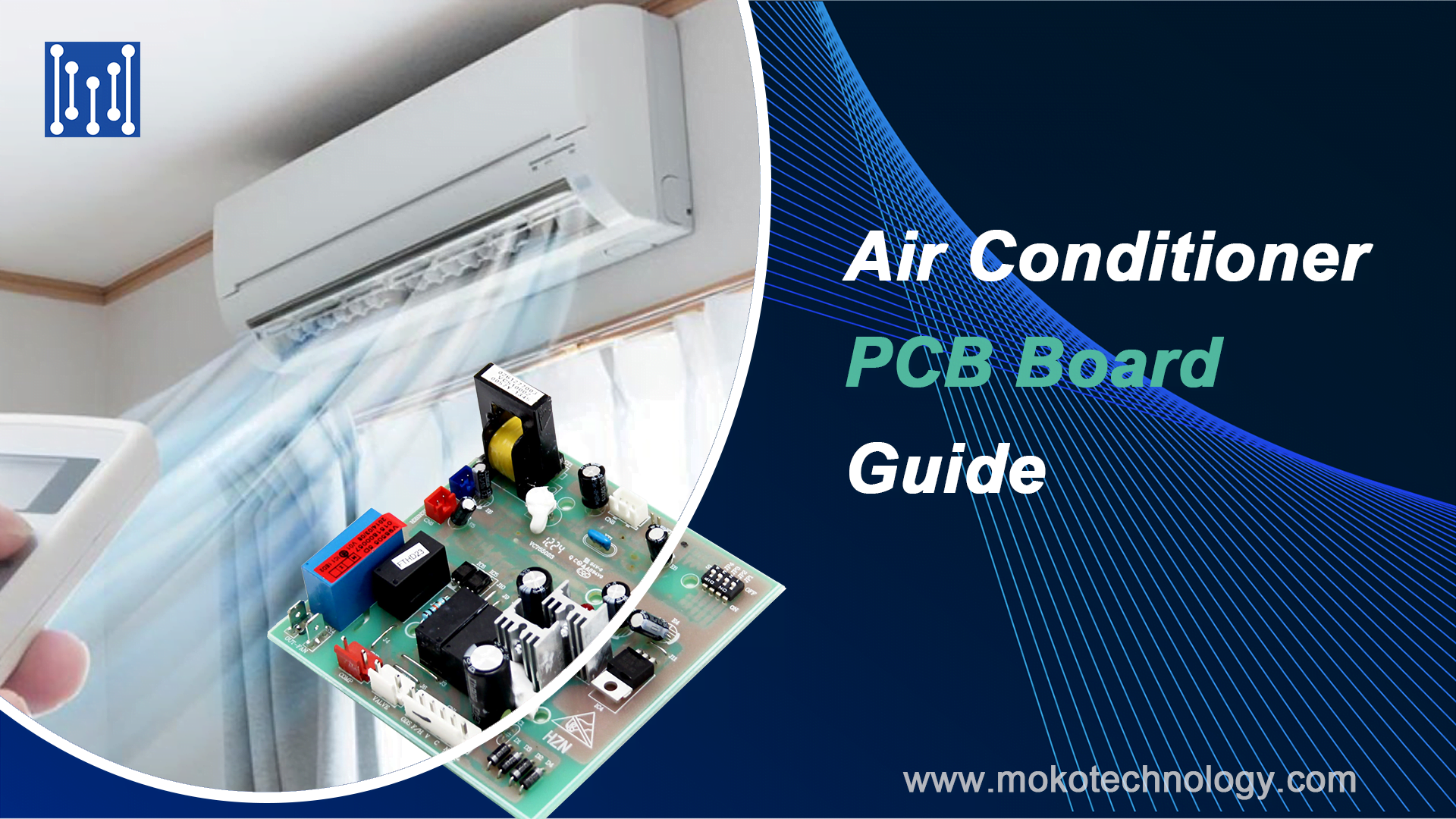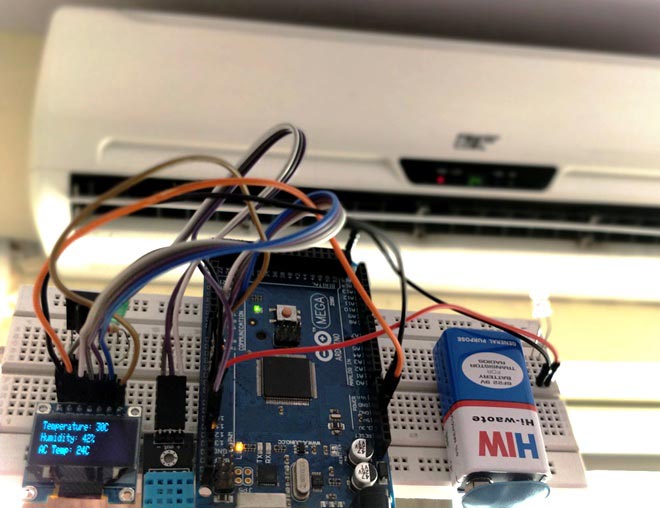Air Conditioner PCB Board: A Comprehensive Guide


Thousands of years ago people were living in harsh environments and the intense summer heat was simply unbearable. However, we don’t have to endure such conditions thanks to the invention of smart devices such as air conditioners. Air conditioners have become a ubiquitous appliances in modern households, workplaces, and public spaces. They offer comfort by controlling the levels of temperature and humidity in a particular setting. Air conditioners are complex devices with various components working in tandem to create the desired indoor environment. One of the most important components of an air conditioner is the printed circuit board (PCB). In this guide, we will discuss the air conditioner PCB board in detail, from its definition, and types to its functions and so on. Let’s read on.
What is an Air Conditioner PCB?
A printed circuit board comprises an insulating material, such as fiberglass or plastic, with etched conductive pathways on it. It is the foundation of many electronic devices, including air conditioners. The PCB in AC is responsible for controlling and regulating the system’s various functions. It is the brain of the air conditioner, and it plays a crucial role in ensuring that the device works efficiently and effectively.
Common Types of Air Conditioner PCB


-
High Temperature PCB
High temperature PCBs are typically chosen for air conditioners because they offer several key advantages over standard PCBs. These advantages include:
Heat resistance: Air conditioners generate a significant amount of heat during operation, and high temperature PCBs are designed to withstand these high temperatures without degrading or failing. This means that high temperature circuit boards are less likely to experience issues such as delamination, cracking, or warping, which can result in electrical shorts or other problems.
Improved reliability: Because high temperature PCBs are specifically designed to withstand high temperatures and other harsh operating conditions, they are more reliable than standard PCBs. This means that air conditioners that use high temperature PCBs are less likely to experience failures or breakdowns, which can result in costly repairs or replacements.
Better performance: High temperature boards are also designed to maintain their electrical properties and performance at high temperatures. This means that air conditioners that use high temperature boards are less likely to experience voltage drops, signal loss, or other performance issues that can impact their overall efficiency and effectiveness.
-
High Frequency PCB
Most air conditioners today are often part of smart home systems. This means that you can control their cooling temperature by using the dedicated remote. However, some smart air conditioners even allow you to control their cooling temperature and other performance parameters even when you are not at home. In this case, you have to use a dedicated app for controlling the cooling temperature and other performance parameters of the air conditioner. An air conditioner is able to do this because it has the capability to process signals sent to it from the remote or the cloud servers.
This signal processing means that there are additional cycles on top of the thermal cycles of the HVAC system. If a device is subject to such cycles then the chances of system failure are considerably high. The reason for this is that such high operating cycles mean that the electronic components will have to deal with very high frequencies.
Such high frequencies can not only degrade the electronic performance but also contribute to noise inclusion. Therefore, it is empirical that we use an air conditioner circuit board that is not prone to consequences from such high frequencies. Hence, High Frequency PCB seems like a great fit for use in air conditioners. The reason for this is that they come with special laminates that allow easy operations at high frequencies. On top of that, this special laminate allows for better able to handle the high heat transfer through the board. The biggest benefit of using High Frequency PCB is that your air conditioning system will incur minimum noise.
-
Rigid PCB
Advanced appliances such as an air conditioner involve high-end mechanics and are basically HVAC systems. So, the components we use in them are often subject to a lot of thermal stresses. If we use a normal PCB for air conditioner then chances are that its performance will decrease and the entire system might collapse. An air conditioner involves numerous heating and cooling cycles. This means that the normal PCB will have to face frequent thermal expansion and thermal contraction.
Therefore, the normal PCB will lose its dimensions, shape, and form. If this happens then the PCB will fail and its functionality won’t meet the set benchmark. Therefore, we need an air conditioner circuit board that has remarkable dimensional stability and doesn’t change its shape or form under any conditions.
So, we can choose a rigid PCB for use in any given air conditioner because it has amazing dimensional stability and is not prone to deformation due to thermal stresses. These kinds of PCB boards are manufactured by using a rigid substrate. This rigid substrate is responsible for supplying strength and durability to this kind of PCB. Hence, a rigid PCB has a higher lifespan and is able to function well even at elevated temperatures. That is why it is the perfect fit for use in HVAC systems such as air conditioners.
The Functions of an Air Conditioner PCB
Control of the Compressor
The compressor is the heart of an air conditioner. It compresses the refrigerant and circulates it through the system. The PCB controls the compressor by regulating the voltage and frequency supplied to it. The PCB also monitors the compressor’s performance and temperature to ensure that it is functioning correctly.
Control of the Fan
The fan is responsible for circulating the air in the room. The PCB controls the fan’s speed by regulating the voltage supplied to it. The PCB also monitors the fan’s performance and speed to ensure that it is functioning correctly.
Temperature Control
By monitoring the room and evaporator coil temperatures, the PCB regulates the compressor and fan speeds to sustain the desired temperature. The PCB also controls the defrost cycle, which removes the frost that accumulates on the evaporator coil.
Power Management
The PCB manages the power supply to the various components of the air conditioner. It regulates the voltage and current supplied to each component to ensure that they receive the correct amount of power.
Communication
The PCB communicates with the remote control and displays the device’s status on the display panel. It also communicates with other electronic devices, such as thermostats and smart home systems.
The Basic Requirements of PCB Boards in an Air Conditioner
Maintain Size and Shape
The size and shape of the PCB board should be suitable for the air conditioner unit where it will be installed. It should fit properly within the space allotted for it. Furthermore, circuit boards used in air conditioners should be able to maintain their shape, form and size, ensuring that their performance and functionality will not be compromised, which would cause the entire system to fail.
Withstand Temperature Fluctuations
Since an air conditioner is an HVAC system, therefore, we often observe rigorous and intense heat transfer and temperature fluctuations within the air conditioner. Hence, we need an air conditioner PCB board that can endure these fluctuations in temperature and intense heat transfer.
Withstand a Large Number of Cycles
The air conditioner removes the warm air from inside the room. At the same time, it takes the air from the outside environment and injects it inside the room after cooling it. For this purpose, we often use liquid gases to cool the air. These processes often involve intense heat cycles such as condensation, compression, expansion, contraction, accumulation, and finally evaporation. These processes are often performed in a cycle and on a given day these cycles are repeated hundreds of times. Hence, we need an air conditioner PCB board that has the ability to withstand these large number of cycles.
What Causes an AC PCB to Fail?
Electrostatic discharge (ESD) – When handling PCBs, a buildup of static electricity on a technician’s clothes or tools can discharge onto the PCB and damage sensitive components like integrated circuits. Using anti-static mats and bracelets helps prevent ESD.
Improper input voltage – Applying incorrect voltage or current to a PCB during installation can destroy circuits. Technicians must carefully follow voltage guidelines in the AC unit’s specifications.
Short circuits – Dust, moisture, or loose wiring can create shorts between contacts on a PCB which can quickly lead to overheating and burnt circuits.
Dust, moisture, heat – Accumulation of dust acts as an insulator, trapping heat given off by PCB components, leading to thermal failure. Moisture corrodes contacts. Proper filter cleaning and sealing can prevent buildup.
Physical impact – If a PCB is dropped, connections can crack or detach from the board. Careful handling prevents damage. Vibration during shipping can also weaken solder points. Proper packing prevents shipping damage.
Aging – Years of expanding/contracting with temperature swings can weaken solder joints. Component lifespan decreases with use as circuits degrade over time. Overall, aging reduces the PCB’s structural and electronic integrity.
Repairing AC Circuit Boards – Is it Worth the Cost?
Air conditioners contain printed circuit boards that can fail over time. When an AC unit stops working, the problem often traces back to a faulty PCB. Replacing the entire AC unit can be expensive, so some homeowners opt to repair the PCB instead. While PCB repair costs less than full AC replacement, there are pros and cons to consider. On one hand, a repaired PCB can get an AC unit working again for a fraction of replacement cost. However, repaired PCBs may fail again sooner than a new one would. The repair work itself also varies in quality. Overall, PCB repair presents a budget-friendly option, but units with chronic PCB issues may warrant the investment of a brand-new air conditioner.
Further reading: How to Repair Circuit Boards?
Where to Find Reliable Air Conditioner PCB Boards
MOKO Technology is a renowned brand name in the global PCB industry. We are known for our quality products which ensure superior performance. We specialize in providing dedicated PCBs for your specific needs and requirements. We have vast experience in the design and development of High Temperature PCB, Rigid PCB, and High Frequency PCB. So, if you are looking to manufacture high-end appliances of superior quality such as a top-notch air conditioner then feel free to reach out to us. We are very skilled in mass production of air conditioner circuit board among many others. We believe in customer satisfaction and we guarantee that your experience with MOKO Technology will be one of a kind.
Recent Posts
Impedance Matching: A Critical Factor in High-Speed PCB Design
Impedance matching has become a cornerstone of the signal integrity in the realm of high speed PCB…
How to Clean a Circuit Board Safely and Effectively?
It is important to learn how to clean a circuit board properly if you’re working…
Counterbore vs Countersink: Which to Choose for Your PCB?
When designing PCBs, selecting the appropriate type of holes for fasteners is crucial. And much…
PCB Copper Foil: Types, Properties & How to Choose
PCB copper foil is one of the most critical materials in the printed circuit board…
MOKO Technology Launches Vietnam Manufacturing Base in February 2025
Shenzhen, China - February 11, 2025 - MOKO Technology, a leading global electronics manufacturing service…
PCB Solder Mask: What It Is and Why Every Circuit Board Needs It?
While most people focus on the components and copper traces that make up PCBs, there's…


